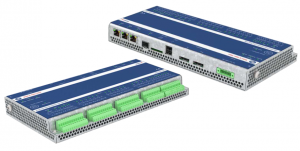continuously

Fault detection, Trending and Identification
The VCM-3 has been designed to continuously acquire different characteristic values from the sensor raw input signal of the connected sensor. Each of these characteristic values is in ideal a “Descriptor” of a characteristic failure mode and indicates the status of the machine component with respect to that potential failure mode. An increase in the level of a descriptor is a symptom of a developing fault on the machine component.
A descriptor respectively series may be the value of NX for indicating misalignment or unbalance, or the ECU value, which indicates a bearing fault. A descriptor value may also be used to express the severity of the vibration level of the component compared to international standards such as ISO 10816. The powerful inbuilt signal processing capabilities enables the VCM-3 to extract a huge number of descriptors measured simultaneously on the independent measurement channels.
Experience shows that long term trending on the each of the descriptors derived from the input signal provides a very sensitive measure of the operational state of the machine and gives a very early indication of a progressing fault of machine component, thus maximizing lead time to plan a service shutdown or to provide enough evidence to postpone a repair to the next scheduled shutdown.
Key Features and System Benefits
Fault detection – Descriptors for trending
VCM-3 is using descriptors for fault detection. A descriptor is created by post processing the raw vibration signal into one or more scalar values. A descriptor value is very well suited for long term
trending to indicate failure modes of machines. VCM-3 measures a large range of descriptors such as real time standardized bandpass filters for true energy measurements, and envelope bandpass for bearing fault detection.
High number of input channels/High value
Suitable for advanced condition monitoring from one to four or even six machines in one device. All input channels are sampled simultaneously (synchronous sampling).
– 12 Dynamic (AC/DC) vibration input channels, sampled at 204,8K samples per second.
Field mountable edge device
Environmentally robust -40 to +60 °C (-40F to+140F) operation with built in protocols for MODBUS TCP/IP and OPC UA. VCM-3 can be installed as field monitors mounted at remote locations next to the machines* or in an instrument cabinet.
Robust cybersecurity
The ports in our VCM-3 hardware have been hardened with encryption and designed to push data out to upper networks without exposing critical infrastructure to external vulnerabilities. It is specifically designed to work with firewalls, data diodes, and multi-tiered networks to meet industry’s most stringent data security requirements.
OPC UA Server embedded in the device
Remove the need for additional software and infrastructure as OPC UA (acting as a Server) is supported directly from the hardware device.
Field proven
Based off the third generation of the world’s most popular wind turbine monitoring system.
VCM-3 Homepage (embedded Web server)
Spectrum (FFT, Hanning) and time waveform (oscilloscope) plots can be accessed via internet browser for each dynamic vibration input channel via the built-in Homepage (Web server). This can perfectly be used for commissioning or remote diagnostic access use cases.
Rolling Element Bearing (REB) descriptors
- Acceleration band pass with flexible filter corners (rms, peak, crest)
- Velocity (integrated from acceleration) with flexible filter corners (rms, ISO 10816 / 20816 support)
- Envelope Bearing Condition ECU
Designed for the future
(without change of VCM-3 device hardware) The computational power, the existing sensor input and analysis capabilities, and the flexibility in the design make VCM-3 a technology leader for many years to come. Supports any state-of-the-art condition monitoring method and provides a platform for customizations and development of future new monitoring methods.
